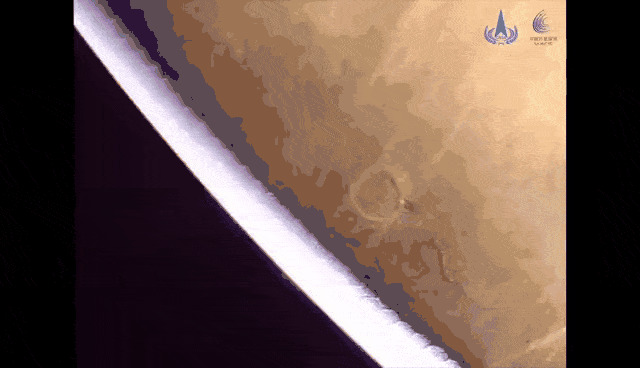
China successfully landed its six-wheeled Zhurong rover on Mars, early on May 14. Similar to the touchdown of its American counterpart, Perseverance, which reached the red planet in February, the Chinese vehicle used a combination of a protective capsule, a parachute, and a rocket platform to make the descent. Now, Zhurong has released its first pictures from the Utopia Planitia landing site, a vast region in the planet’s northern hemisphere.
Up until Zhurong, only NASA had mastered landing on Mars. All other countries that tried before either crashed or lost contact soon after their vehicle reached the surface.
Zhurong, which means God of Fire, was carried to Mars on the Tianwen-1 orbiter, which arrived above the planet in February. Since then, the probe had been patiently orbiting the planet, surveying Utopia Planitia in search of the safest place to target a landing.
The images released by the China National Space Administration include a black-and-white photo taken by the obstacle avoidance camera from the front of the rover, showing a ramp from the lander extending to the surface. The message is clear: this is supposed to be the historical moment right before the rover’s wheels touch the surface of Mars.

The second image is in color and shows the back of Zhurong, including the rover’s antenna and fully deployed solar panels.
Additionally, China released a brief video showing the lander separating from the orbiter that carried the rover to Mars. This dive through Mars’ atmosphere, known as the “seven minutes of terror”, is considered the most challenging part of any voyage to Mars’ surface.

Zhurong’s successful landing on Mars is the latest in a series of major milestones for China’s space program. In December 2020, China successfully landed a spacecraft on the moon’s surface in a mission to retrieve lunar surface samples, only the third country to do so after the United States and the Soviet Union decades ago. In 2016, China launched its second space laboratory, Tiangong 2, and is planning the launch of a third space station soon.
Unlike its American predecessors, Zhurong has a very flexible schedule. Its mission is set to run for only 90 days during which it will use its instruments to investigate local rocks and the general natural environment, including the weather. The colossal Utopia Planitia basin, measuring over 3,000 kilometers across, was formed by an impact early in the planet’s history. Scientists believe it once held an ancient ocean.
The next rover bound for Mars is Rosalind Franklin, previously known as the ExoMars rover, part of the international ExoMars program led by the European Space Agency and the Russian Roscosmos State Corporation. The mission was scheduled to launch in July 2020 but was postponed to 2022.
Was this helpful?



